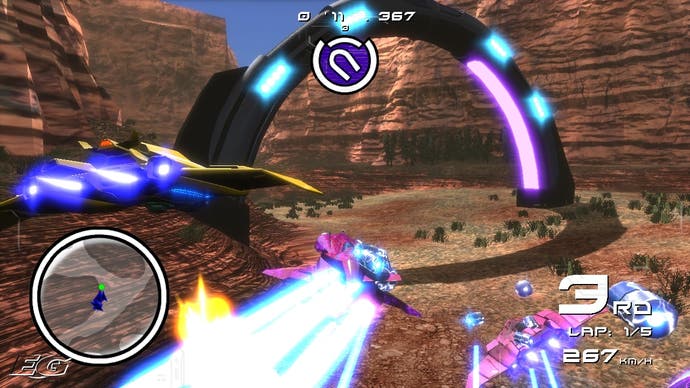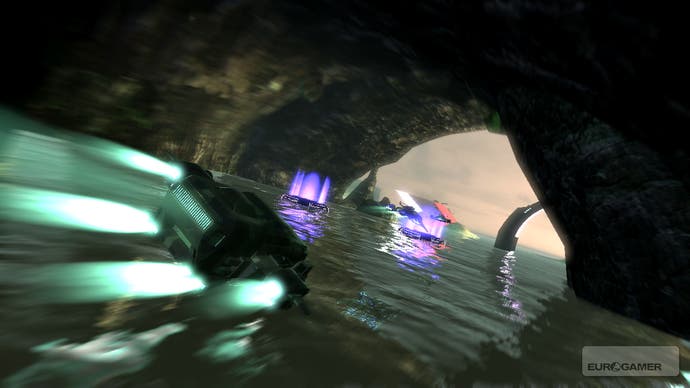Fatal Inertia
More of a flesh-wound, really.
One of the best things about the new generation of consoles is the free and easy availability of demos - the very definition of try before you buy, right there at your fingertips on Xbox Live Marketplace and PlayStation Store.
However, demos are only a great thing if they actually represent the game that eventually hits the shelves. A great demo for a game that turned out to be dull would leave you feeling pretty cheated, no doubt - but what are we to make of an utterly dreadful demo for a game that turns out not to be that bad by any means?
We've been scratching our heads over that question for a few days now, after taking delivery of final code of Koei's new futuristic racing title, Fatal Inertia. The Xbox Live demo for the game was, in no uncertain terms, bloody awful (something you were all quick to point out when we published a moderately flattering preview of the game a while back).
Yet the game itself, we can now confirm, really isn't that bad - leaving us to wonder why on earth Koei would undersell its own product in this way. Ah, the tangled web of videogame publishing!
Quickly now
Taking its cues equally from high speed racing titles like WipEout and weapon-heavy cart racing games like Mario Kart, Fatal Inertia is a style of game most players will find instantly familiar - a hovering, futuristic racer with lots of explosions. It's also a style of game which has been done extremely well by other franchises (primarily WipEout and F-Zero), which does leave Koei's entry into the genre with a lot of catching up to do.

It's not quite a challenge that Fatal Inertia manages to meet, sadly - and it's unlikely that the developers at Nintendo or Sony Liverpool will be too worried just yet. Fatal Inertia introduces a host of great ideas to the genre, and boasts occasional moments of genius in its track design - but it's let down by some glaring problems with the technical implementation which consign the game to the ranks of "passable fun" rather than "instant classic".
The action takes place in a number of different zones, each of which has a unique visual style - ranging from idyllic tropical islands, via twisting desert canyons and jagged mountain-tops, through to volcanic caves and frozen seas. Each of these areas plays host to a number of different circuits, some of which are specifically balanced for a certain type of play - so you get a few which are easy to navigate but full of weapon pads, some which are designed to test your driving skills as much as possible, and so on.
In itself, that's a nice addition to the genre - but what's even better is the ability to customise your races with a variety of different options and racing conditions. You can choose to race at different times of day, or add an adverse weather condition to the track (a blizzard, a thunderstorm, whatever); then you can select racing options which restrict the types of weapons and power-ups available on the track, or which change the winning conditions for the race.

This level of customisation gives Fatal Inertia a surprising amount of replayability - which isn't half bad considering that the game is already blessed with a fairly large number of tracks. The selection of weapons available in the game is also interesting and varied - while you'll be instantly familiar with some relatively dull old reliables like smoke-screens, Koei has done its level best to mix things up with a selection of weapons that play on Fatal Inertia's solid Havok physics model.
So, for example, you've got the tether - essentially a long chain which you can either fire at two enemy vehicles, tying them together and making it likely that they'll both crash, or at a piece of scenery, allowing you to use it to whip yourself around a tight corner. Or the magnets; a swarm of heavy little homing magnets which attach to enemy craft and add drag and crap handling to the mix, slowing them down and making steering sluggish until they're shaken off.
Even some old favourites get an interesting makeover. The rocket seems familiar at first, but it doesn't actually explode when you shoot it at an enemy - instead, it attaches to their craft and fires a powerful boost, which of course will send their vehicle flying into a spin or off at an angle. A secondary fire mode actually clips the rocket onto your own vehicle, giving you a massive boost of speed.


